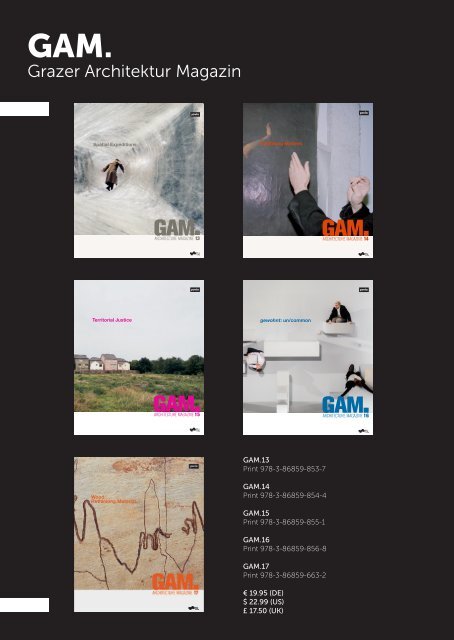JOVIS Katalog Frühjahr 2022
Sie wollen auch ein ePaper? Erhöhen Sie die Reichweite Ihrer Titel.
YUMPU macht aus Druck-PDFs automatisch weboptimierte ePaper, die Google liebt.
ISSN 1612-9482<br />
ISBN 978-3-86859-853-7<br />
26<br />
GAM.<br />
Grazer Architektur Magazin<br />
13<br />
14<br />
d Fortwickenger<br />
r Bau-<br />
Formes<br />
sehr<br />
d Inrialien<br />
fen.<br />
en diejekte,<br />
Spatial Expeditions<br />
Raum wird nicht nur visuell, sondern mit allen Sinnen erlebt. Dennoch<br />
werden in Entwurf und Rezeption von Architektur haptische, akustische<br />
und osmische Wahrnehmungen oft kaum berücksichtigt. Dementsprechend<br />
gibt es in der Architekturdisziplin keinen kontinuierlichen Diskurs<br />
zum Thema Raumwahrnehmung. GAM.13 Spatial Expeditions möchte<br />
diese Lücke schließen. Die Methode der Expedition ermöglicht dabei<br />
einen experimentellen Umgang und bietet die Chance, neue Erkenntnisse<br />
und Sichtweisen auf den gebauten Raum zu gewinnen. Dabei werden<br />
Techniken der Wahrnehmung aus Architektur, bildender Kunst, Musik,<br />
Tanz und anderen artverwandten Disziplinen erprobt. GAM.13 stellt<br />
damit selbst eine Expedition zu experimenteller Architektur und den<br />
unerforschten Aspekten des gebauten Raumes dar.<br />
Spatial Expeditions<br />
Exhibiting Matters<br />
Exhibiting Matters<br />
s of<br />
veloption<br />
ives,<br />
nical<br />
nnovaering<br />
ment<br />
Affairs<br />
archi-<br />
Space is experienced not only visually, but with all the senses. Despite this,<br />
the design and reception of architecture often barely take haptic, acoustic,<br />
and osmic perceptions into account. Consequently, in the architecture discipline<br />
there is no continuous discourse on the topic of spatial perception.<br />
GAM.13 Spatial Expeditions seeks to fill this gap. The method of the expedition<br />
enables an experimental approach and provides the opportunity to<br />
gain new insights and perspectives with regard to built space. It explores<br />
perceptual techniques from the fields of architecture, the visual arts, music,<br />
dance, and other related disciplines. GAM.13 therefore represents an expedition<br />
into experimental architecture and the unexplored aspects of built space.<br />
tive<br />
Mit Beiträgen von | With contributions by<br />
Sam Auinger<br />
Sebastian Behmann<br />
Karen van den Berg<br />
Neeraj Bhatia<br />
Christina Buck<br />
Eric Ellingsen<br />
Irmgard Frank<br />
Claudia Gerhäusser<br />
Martin Grabner<br />
Franziska Hederer<br />
Shreepad Joglekar<br />
Klaus K. Loenhart<br />
Malcolm McCullough<br />
NUMEN/For Use<br />
Dietmar Offenhuber<br />
Philippe Rahm<br />
Gabi Schillig<br />
Marta Traquino<br />
Samuel Zwerger<br />
13<br />
14<br />
15<br />
16<br />
n<br />
s<br />
en<br />
i-<br />
ng,<br />
een<br />
hreif<br />
absped<br />
ist.<br />
Territorial Justice<br />
GAM.16 gewohnt: un/common stellt den vorherrschenden Grundrisstypologien<br />
des standardisierten, neoliberalen Wohnungsmarkts ungewöhnliche<br />
Modelle gemeinschaftlichen Wohnens gegenüber. Statt leistbaren<br />
Wohnraum über die ständige Minimierung von Wohnflächen aufrecht<br />
zu erhalten, schlägt GAM.16 ein zusätzliches Angebot an Raum vor, den<br />
man sich teilt, in dem die ursprüngliche (räumliche) Einheit von Wohnungen<br />
geöffnet und erweitert wird, um andere Funktionen oder Personen<br />
aufzunehmen. GAM.16 plädiert für mehr Kommunalität und untersucht<br />
kollaborative und koproduktive Wohnkonzepte, die leistbaren und attraktiven<br />
Wohnraum für unterschiedliche Lebenssituationen schaffen und als<br />
„Probebühnen“ gemeinschaftlichen Wohnens dieses Thema (wieder) auf<br />
die Agenda der Architektur setzen.<br />
Territorial Justice<br />
gewohnt: un/common<br />
gewohnt: un/common<br />
ces,<br />
elds<br />
edienergy,<br />
at<br />
s<br />
uld<br />
and<br />
GAM.16 gewohnt: un/common juxtaposes the prevalent floor-plan<br />
typologies of the standardized, neoliberal housing market with unconventional<br />
models of community living. Instead of preserving affordable living<br />
space by perpetually minimizing residential spaces, GAM.16 proposes the<br />
creation of additional areas to be shared—by opening and expanding the<br />
original (spatial) apartment unit to embrace other functions or persons.<br />
GAM.16 advocates more communal spirit and examines collaborative and<br />
co-productive housing concepts which create affordable and attractive living<br />
space for different life situations—housing concepts as “experimental<br />
stages“ for communal living that (re)establish this theme as an aspiration<br />
of architecture.<br />
Mit Beiträgen von | With contributions by<br />
a<br />
Massimo Bricocoli<br />
Gregory Cowan<br />
Heike Delitz<br />
Alexander Hagner<br />
Rebekka Hirschberg<br />
Marson Korbi<br />
Gesa Königstein<br />
Andreas Lichtblau<br />
Christina Linortner<br />
Karla Mäder<br />
Jakob Öhlinger<br />
Manfred Omahna<br />
Gennaro Postiglione<br />
Nikolai Roskamm<br />
Jomo Ruderer<br />
Stefania Sabatinelli<br />
Philipp Markus Schörkhuber<br />
Fritz Strempel<br />
Günther Uhlig<br />
Sigrid Verhovsek<br />
ISSN 1612-9482<br />
ISBN 978-3-86859-856-8<br />
15<br />
16<br />
9 783868 598568<br />
GAM.13<br />
Print 978-3-86859-853-7<br />
GAM.14<br />
Print 978-3-86859-854-4<br />
GAM.15<br />
Print 978-3-86859-855-1<br />
GAM.16<br />
Print 978-3-86859-856-8<br />
GAM.17<br />
Print 978-3-86859-663-2<br />
€ 19.95 (DE)<br />
$ 22.99 (US)<br />
£ 17.50 (UK)


















